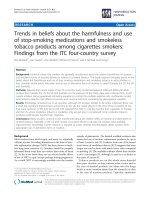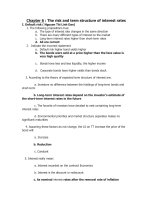Chapter Four The Meanings and Dimensions of Culture
Bạn đang xem bản rút gọn của tài liệu. Xem và tải ngay bản đầy đủ của tài liệu tại đây (111.86 KB, 20 trang )
Chapter Four
The Meanings and Dimensions
of Culture
McGraw-Hill/Irwin
Copyright © 2012 by The McGraw-Hill Companies, Inc. All Rights Rese
The Meanings and Dimensions
of Culture
The specific objectives of this chapter are to
1. DEFINE the term culture, and discuss some of the
comparative ways of differentiating cultures.
2. DESCRIBE the concept of cultural values, and
relate some of the international differences,
similarities, and changes occurring in terms of both
work and managerial values.
3. IDENTIFY the major dimensions of culture
relevant to work settings, and discuss their effects
on behavior in an international environment.
4. DISCUSS the value of country cluster analysis
and relational orientations in developing effective
international management practices.
4-2
The Nature of Culture
Culture is
Acquired knowledge that people use to interpret
experience and generate social behavior. This
knowledge forms values, creates attitudes, and
influences behavior.
4-3
The Nature of Culture
Characteristics of culture
Learned
Shared
Trans-generational
Symbolic
Patterned
Adaptive
4-4
Cultural Diversity
How Culture Affects Managerial Approaches
Centralized vs. Decentralized Decision Making
In some societies, top managers make all important
organizational decisions
In others, these decisions are diffused throughout
the enterprise, and middle- and lower-level
managers actively participate in, and make, key
decisions
4-5
Cultural Diversity
How Culture Affects Managerial Approaches
Safety vs. Risk
In some societies, organizational decision makers
are risk averse and have great difficulty with
conditions of uncertainty
In others, risk taking is encouraged, and decision
making under uncertainty is common
4-6
Cultural Diversity
How Culture Affects Managerial Approaches
Individual vs. Group Rewards
In some countries, personnel who do outstanding
work are given individual rewards in the form of
bonuses and commissions
In others, cultural norms require group rewards,
and individual rewards are frowned upon
4-7
Cultural Diversity
How Culture Affects Managerial Approaches
Informal Procedures vs. Formal Procedures
In some societies, much is accomplished through
informal means
In others, formal procedures are set forth and
followed rigidly
4-8
Cultural Diversity
How Culture Affects Managerial Approaches
High Organizational Loyalty vs. Low
Organizational Loyalty
In some societies, people identify very strongly with
their organization or employer
In others, people identify with their occupational
group, such as engineer or mechanic
4-9
Cultural Diversity
How Culture Affects Managerial Approaches
Cooperation vs. Competition
Some societies encourage cooperation between
their people
Others encourage competition between their people
4-10
Cultural Diversity
How Culture Affects Managerial Approaches
Short-term vs. Long-term Horizons
Some culture focus most heavily on short-term
horizons, such as short-range goals of profit and
efficiency
Others are more interested in long-range goals,
such as market share and technological
developments
4-11
Cultural Diversity
How Culture Affects Managerial Approaches
Stability vs. Innovation
The culture of some countries encourages stability
and resistance to change
The culture of others puts high value on innovation
and change
4-12
Business Customs in South Africa
Arrange a meeting before discussing business
over the phone
Make appointments as far in advance as
possible
Maintain eye contact, shake hands, provide
business card
Maintain a win-win situation
Keep presentations short
4-13
Values in Culture
Values
Basic convictions that people have about
Right and wrong
Good and bad
Important and unimportant
Learned from culture in which the individual is
reared
Differences in cultural values may result in varying
management practices
4-14
Hofstede’s Cultural Dimensions
1.
2.
3.
4.
Power distance
Uncertainty avoidance
Individualism/collectivism
Masculinity/femininity
4-15
Hofstede’s Cultural Dimensions
Power distance
The extent to which less powerful members accept
that power is distributed unequally.
High power distance countries: people blindly
obey superiors; centralized, tall structures (e.g.,
Mexico, South Korea, India)
Low power distance countries: flatter,
decentralized structures, smaller ratio of
supervisor to employee (e.g., Austria, Finland,
Ireland)
4-16
Hofstede’s Cultural Dimensions
Uncertainty avoidance
The extent to which people feel threatened by ambiguous
situations; create beliefs/institutions to avoid such situations.
High uncertainty avoidance countries: high need for
security, strong belief in experts and their knowledge;
structure organizational activities, more written rules, less
managerial risk taking (e.g., Germany, Japan, Spain)
Low uncertainty avoidance countries: people more
willing to accept risks of the unknown, less structured
organizational activities, fewer written rules, more
managerial risk taking, higher employee turnover, more
ambitious employees (e.g., Denmark and Great Britain)
4-17
Hofstede’s Cultural Dimensions
Individualism
The extent to which people look after themselves
and immediate family only.
High individualism countries: wealthier,
protestant work ethic, greater individual initiative,
promotions based on market value (e.g., U.S.,
Canada, Sweden)
High collectivism countries: poorer, less
support of Protestant work ethic, less individual
initiative, promotions based on seniority (e.g.,
Indonesia, Pakistan)
4-18
Hofstede’s Cultural Dimensions
Masculinity
A cultural characteristic in which the dominant
social values are success, money, and things.
High masculine countries: stress earnings,
recognition, advancement, challenge, wealth;
high job stress (e.g., Germanic countries)
High feminine countries: emphasize caring for
others and quality of life; cooperation, friendly
atmosphere., employment security, group
decision making; low job stress (e.g., Norway)
4-19
Review and Discuss
1. What is meant by culture?
2. What is meant by value?
3. What are the dimensions of Hofstede’s
model?
4. Will cultural differences decline or intensify
as roadblock to international understanding?
5. Describe Trompenaar’s research. What can
we learn from Trompenaar’s study?
4-20









